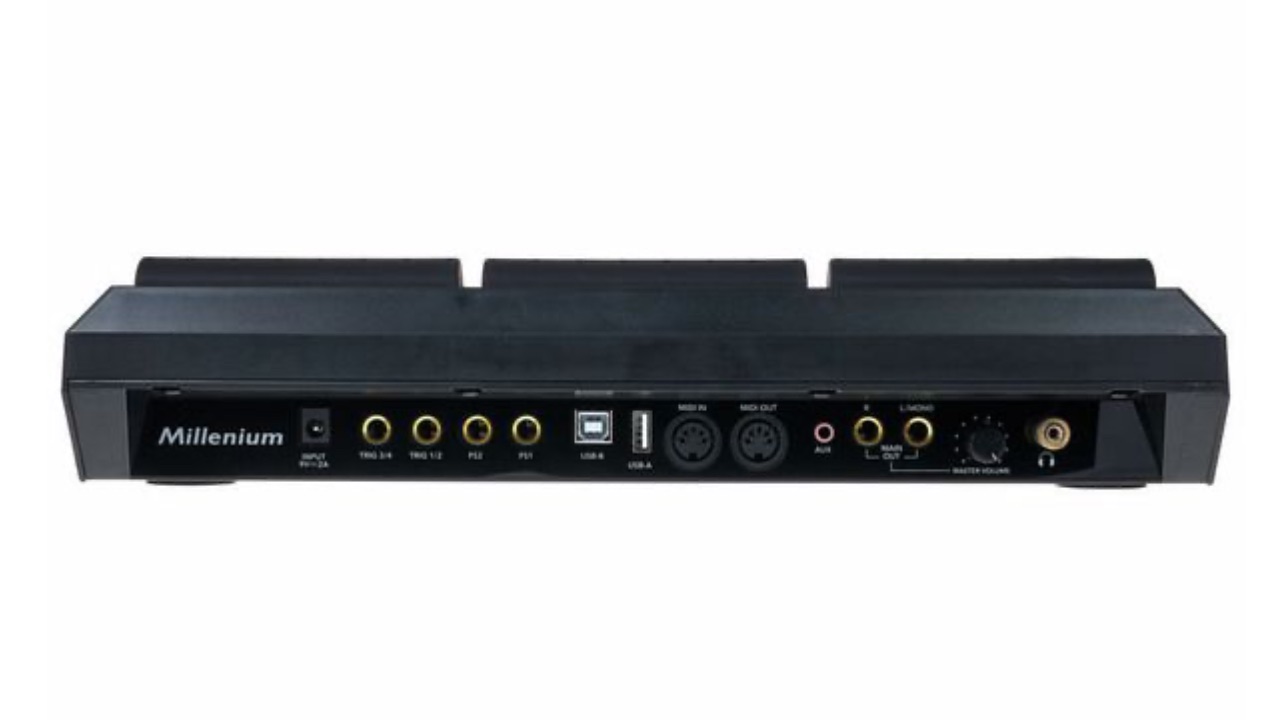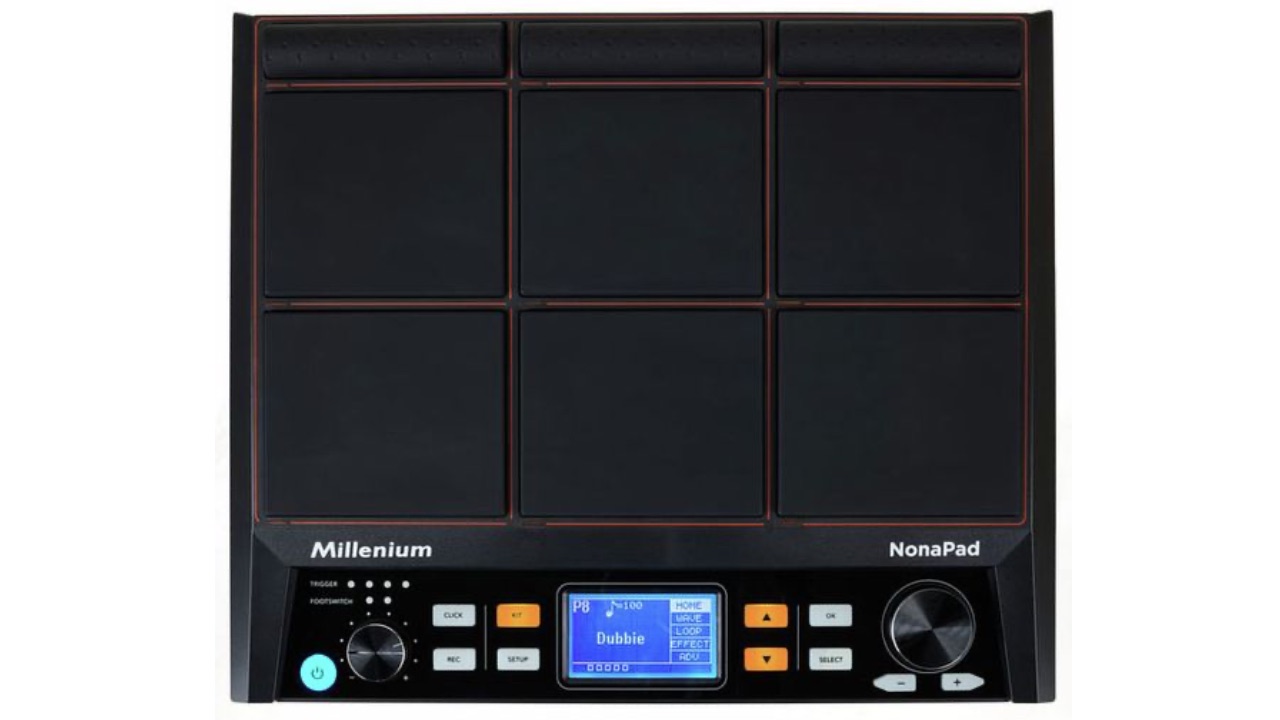MusicRadar Verdict
It's an incredibly affordable solution for a wide range of sounds as well as custom samples on a budget. Some of the usability is made tricky by menus, but overall it delivers a lot for the money.
Pros
- +
Nine playing surfaces
- +
External triggers
- +
Decent sounds included
- +
User sample-compatible
Cons
- -
The menus are a bit fiddly
- -
We had limited success using USB memory sticks with the NonaPad
MusicRadar's got your back
Hybrid drumming - that is, blending acoustic drums with electronic pads, triggers and samples - is one of the biggest developments to the drum kit this er…millenium - with the need for augmenting our sounds to match recordings and production of popular music more important than ever.
It’s also more affordable than it’s ever been to start adding electronics into your sounds, as evidenced by Millenium Drums’ latest release, the NonaPad. So, if you’re looking to incorporate some additional sounds into your kit on a budget, step this way.
Millenium NonaPad: What is it?
You might be familiar with the NonaPad already, either by its Millenium-branded name, or one of the other few brands out there marketing the same pad under a different model name (see the Ddrum Nio Percussion Pad for a red version of the same product). But the NonaPad currently clocks in at just £199 from European retail giant, Thomann.
So what is it? Let’s start with what it’s not. When confronted with a square-ish grid of pads, most drummers will think of the Roland SPD-SX, which along with the SPD-S before it, and now the SPD-SX Pro have been game-changers in the hybrid drumming market for the best part of two decades.
A big function of pads of this kind are their ability to be do-it-all solutions for running live backing tracks and triggering samples, and are essentially samplers with pads built-in.
While the NonaPad apes the look of an SPD-SX, its functionality is rather more on par with a percussion pad with sample playback capabilities.
You’ve got the two rows of square pads, and a top edge equipped with three thinner pads giving you nine on-board playing surfaces. That’s where the name comes from. To the back, there’s a pair of stereo trigger inputs giving you a potential four further voices if you hook up dual-zone rim/head triggers or pads, plus there are another two footswitch inputs which can be configured for a bass drum pad, as well as offering hi-hat pedal control.
Internally there are 308 assignable sounds, arranged into 30 preset kits; effects including a limiter, reverb and three-band EQ; a metronome, recording functionality and importantly, 512mb of memory to which you can import your own wav samples.
“Hang on, that sounds like a cut-price SPD-SX to me!”. Again, at first glance - it's a stand-mountable (stand not included) drum pad. But let’s get the first big caveat out of the way.
Part of the SPD-SX’s appeal is its ability to contain your backing tracks, run a click track, and route everything flexibly so that the audience only hears the music and not the click. This is not what the NonaPad claims to do.
There’s a single set of outputs on the back, which are mirrored by the headphone output. Further to this, while you’ve got plenty of sample-import space, there’s a limit to the length of each file.
So, if running backing tracks from a single piece of hardware is your aim, this isn’t going to be a one-stop solution for a few hundred quid less.
But don’t click away yet, because there are plenty of things the NonaPad can do, and as we’ll get to, some half-way workarounds that could make it an affordable contender for this purpose.

Millenium NonaPad: Performance and Verdict
Back-tracking from backing tracks for a moment, we’re going to assume that your main reason for considering a pad such as this is to augment the sound of your kit.
The beauty of having so many playing surfaces and kits is that they can be percussion one minute, an 808 the next, a pitched-up Amen sample or electronic effect - or any combination of those and more all at once.
The internal sounds cover all of these bases, and are surprisingly good given the overall price of the NonaPad. Then throw-in the ability to bring your own sounds in and assign them to the pads for playing, and you’ve got a flexible performance tool.
There are acoustic kits, and thanks to its dual-layering of voices per-pad, many of these are set up with open/closed hi-hats which switch via dynamics.
Obviously with only two sounds (closed and open) it’s a binary option without gradual ‘in-between’ sounds or stepping, but it works well enough if you’re looking for basic playability, particularly on the electronic and drum machine emulations.
As with any unit of this kind, there’s a learning curve of menus and button presses to overcome. The NonaPad’s jog wheel, up and down cursors, select and OK buttons help with this, but we did find ourselves constantly pressing and selecting the wrong function for the first couple of hours of use. It’s not overly complicated, but it’s not fully intuitive either. Once you’ve got used to using it, it won’t be a problem, but be prepared for a little frustration to begin with.
As we’ve already mentioned, you can rig up external pads or triggers, with a generic selection between single and dual-zone models. This is handy if you want to place a pad or trigger at a different physical point on your kit, and we tried it with both a bass drum trigger and separate pad with success.
Once you’ve finished playing with the internal presets and sounds, it’s likely that you’re probably itching to get tinkering with your own samples. The NonaPad can import a mono, 16-bit/44.1kHz file in two ways; via a USB memory stick plugged into the pad, or over a USB cable connection to a computer using its Wave Manager software.
Now, we have many USB sticks ranging from old and small capacity to brand new with more memory than our laptop’s hard disk. Armed with half a dozen or so USB sticks loaded with the same samples, we had hit-and-miss results at getting the sounds into the pad. Sometimes it would recognise them, sometimes it wouldn’t, despite the samples and sticks conforming to the correct format and placement.
A much better solution is the software. It works similarly to the manager for Roland’s SPD-SX and while basic, made loading samples into the NonaPad a lot more straightforward. You load the software, import your samples and drag-and-drop them onto the pad you want to trigger them from. From here, the Wave Manager spits out a kit preset file.
You then place the file onto a USB stick where it’s recognised by the pad for import and hey presto! You can now trigger a car horn sound from your bass drum. We think it could be improved if you could send the files directly to the pad from the software, cutting out the final step. But, remember how much you’re paying.
No, it doesn’t cost a lot. But with the ‘Can it run a track and click?’ question still hanging over us, we decided to see how far we could stretch that sub-£200 price tag. By using some panning and the pad’s link function, plus some external hardware (a small mixer with a headphone output), we were able to re-route our samples so that we could monitor a backing track and click in our in-ears, while sending the track on its own to a powered speaker. So, the answer is yes, you can do it, but not straight out of the box.
Hybrid drumming is here to stay, and it’s clear that - as with most electronic products in any market - you get what you pay for. Here, the frankly laughable amount of money you’re investing vs the level of power you get has been invested in the immediate. That’s build quality and playing feel that is totally serviceable for regular pub gigs; a sound set that’s usable out of the box and some useful additional features.
It omits heavy research and development, and from the usability side (beyond the basics), that’s where you can see how the savings have been made. That said, we were surprised to find the inclusion of the Wave Manager software - for free, and with a bit of time invested in learning the menu structures it does get easier.
As a performance pad nestled amongst your kit, the NonaPad does a great job of providing a lot of additional sounds and playing surfaces. Plus the ability to get your own samples in there as playable instruments is a big bonus, and we can see this being worth way more than you’re paying for it for this application alone. Likewise, it’s a very affordable solution as a MIDI controller too, so if you’re planning on triggering sounds from another device or computer it’s another winner.

Millenium NonaPad: Hands-on demos
ArtOfDrumming
Millenium
Abletondrummer.com
Millenium NonaPad: Specifications

- TYPE: Percussion pad with sample import
- SOUNDS: 608, plus user sample import (512mb)
- KITS: 30
- SOCKETS: L/R outputs, headphone outputs, 2x dual-zone trigger inputs, 2x footswitch, USB host, USB memory, MIDI in/out
- POWER: 9V PSU included
- CONTACT: Millenium Drums
MusicRadar is the number one website for music-makers of all kinds, be they guitarists, drummers, keyboard players, DJs or producers...
- GEAR: We help musicians find the best gear with top-ranking gear round-ups and high-quality, authoritative reviews by a wide team of highly experienced experts.
- TIPS: We also provide tuition, from bite-sized tips to advanced work-outs and guidance from recognised musicians and stars.
- STARS: We talk to musicians and stars about their creative processes, and the nuts and bolts of their gear and technique. We give fans an insight into the craft of music-making that no other music website can.
“I have an original 909 – every time I try to use it I feel like I’m ruining it”: House hero Riva Starr on his studio essentials and his love of analogue synths
“A synthesizer that is both easy to use and fun to play whilst maintaining a decent degree of programming depth and flexibility”: PWM Mantis review
“I feel like that song had everything we needed to come back with”: Bring Me The Horizon’s Lee Malia on Shadow Moses, its riff and the secrets behind its tone, and why it was the right anthem at the right time











